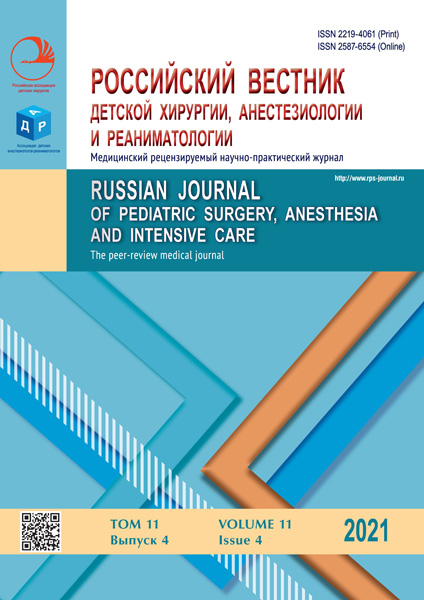Treatment of a newborn with birth trauma of the liver with catheter embolization of a vessel
- 作者: Yanitskaya M.Y.1,2, Shestakova E.V.1,2, Ivanenko A.N.2
-
隶属关系:
- Northern State Medical University
- Arkhangelsk Regional Clinical Hospital, Perinatal center
- 期: 卷 11, 编号 4 (2021)
- 页面: 511-518
- 栏目: Case reports
- URL: https://bakhtiniada.ru/2219-4061/article/view/123553
- DOI: https://doi.org/10.17816/psaic1021
- ID: 123553
如何引用文章
全文:
详细
Birth trauma of the liver with the development of subcapsular hematoma and hemoperitoneum is reported extremely rarely. The slow enlargement of the hematoma also results in delayed development of bleeding symptoms. Noticeable clinical manifestations appear simultaneously when the hematoma ruptures into the abdominal cavity. Later, the symptoms develop very quickly that doctors failed to understand the root cause of the bleeding. The diagnosis is established only during autopsy. When conservative therapy is ineffective, open surgery is conducted; however, the surgery is associated with a high risk of unfavorable outcomes. Herein, we present a clinical case demonstrating successful treatment with endovascular embolization of a vessel due to bleeding from a giant subcapsular hematoma of the liver in a newborn.
The child was born in a settlement of the Arkhangelsk Region and weighed 3480 grams. A vacuum extractor was used to assist the weak mother during delivery. The child was in a critical condition and suffered from asphyxia. Mechanical ventilation was used. At 10 h after birth, the child was taken to a specialized neonatal center of Arkhangelsk (the helicopter flight took 2.5 h). The intensive therapy continued. Negative dynamics followed. At 25 h after birth, hemodynamic indexes decreased. X-ray and ultrasound investigations of the abdominal cavity revealed a large hematoma in the liver. It occupied the entire area of the right liver lobe. Abdominal bleeding was diagnosed. The child was taken to the X-ray department. The newborn underwent urgent endovascular embolization of the right hepatic artery. The bleeding was stopped, and the child’s condition was stable. On follow-up at age 1 year and 5 months, the child’s development was in accordance with age, and blood biochemical parameters were within normal limits. Ultrasound data revealed well recovery of the liver structure.
With extensive birth trauma of the liver, minimally invasive surgery, i.e., endovascular embolization of vessels, can be considered an alternative option to surgical treatment.
作者简介
Maria Yanitskaya
Northern State Medical University; Arkhangelsk Regional Clinical Hospital, Perinatal center
编辑信件的主要联系方式.
Email: medmaria@mail.ru
ORCID iD: 0000-0002-2971-1928
SPIN 代码: 4185-7287
Dr. Sci. (Med.), Assistant Professor
俄罗斯联邦, 51, Troitsky av., Arkhangelsk, 163000; ArkhangelskEkaterina Shestakova
Northern State Medical University; Arkhangelsk Regional Clinical Hospital, Perinatal center
Email: shest-88@list.ru
ORCID iD: 0000-0002-3266-8588
SPIN 代码: 7288-7690
Surgeon
俄罗斯联邦, 51, Troitsky av., Arkhangelsk, 163000; ArkhangelskAleksandr Ivanenko
Arkhangelsk Regional Clinical Hospital, Perinatal center
Email: ivanenko80@inbox.ru
ORCID iD: 0000-0002-4647-1911
SPIN 代码: 2363-3367
Cardiovascular Surgeon
俄罗斯联邦, 51, Troitsky av., Arkhangelsk, 163000参考
- Pignotti MS, Fiorini P, Donzelli G, Messineo A. Neonatal Hemoperitoneum: Unexpected Birth Trauma with Fatal Consequences. J Clin Neonatol. 2013;2(3):143–145. doi: 10.4103/2249-4847.120006
- Voronin AM. A rare case of natal liver trauma in the newborn. Russian journal of forensic medicine. 2017;3(2):32–34. (In Russ.) doi: 10.19048/2411-8729-2017-3-2-32-34
- Kozlov YuА, Kapuller VМ. Birth injuries to the organs of abdominal cavity and retroperitoneal space in newborn infants. Pediatria. Journal named after G.N. Speransky. 2020;99(5):175–184. (In Russ.) doi: 10.24110/0031-403X-2020-99-5-175-184
- French C, Waldstein G. Subcapsular hemorrhage of the liver in the newborn. Pediatrics. 1982;69(2):204–208. doi: 10.1542/peds.69.2.204
- Metzelder ML, Springer A, August C, Willital GH. Neonatal hemoperitoneum caused by a congenital liver angioma. J Pediatr Surg. 2004;39(2):234–236. doi: 10.1016/j.jpedsurg.2003.10.020
- Share JC, Pursley D, Teele RL. Unsuspected hepatic injury in the neonate-diagnosis by ultrasonography. Pediatr Radiol. 1990;20:320–322. doi: 10.1007/BF02013163
- Towbin A, Turner GL. Obstetric factors in fetal-neonatal visceral injury. Obstet Gynecol. 1978;52:113–124.
- Morozov VI, Podshivalin AA, Chigvintsev GE, Yulmetov GA. Natal injuries of visceral organs. Russian Bulletin of perinatology and pediatrics. 2018;63(5):197–201. (In Russ.) doi: 10.21508/1027-4065-2018-63-5-197-201
- Emma F, Smith J, Moerman PH, et al. Subcapsular hemorrhage of the liver and hemoperitoneum in premature infants: report of 4 cases. Eur J Obstet Gynecol Reprod Biol. 1992;44(2):161–164. doi: 10.1016/0028-2243(92)90063-5
- Parilov SL, Klevno VA. Postnatal differential diagnosis of combined birth injury in newborn infants. Forensic medical expertise. 2008;51(6):19–21. (In Russ.)
- Im SA, Lim GY. Subcapsular Hematoma of the Liver in a Neonate: Case Report. J Korean Radiol Soc. 2005;52(1):41–43. (In Korean). doi: 10.3348/jkrs.2005.52.1.41
- Uhing MR. Management of birth injuries. Pediatr Clin North Am. 2004;51(4):1169–1186. doi: 10.1016/j.pcl.2004.03.007
- Gruenwald P. Rupture of liver and spleen in the newborn infant. J Pediatr. 1948;33(2):195–201. doi: 10.1016/s0022-3476(48)80057-0
- Miller BM, Yoon JJ, Kim MH, Gheewala A. Intrapartum rupture of the falciform ligament and umbilical vein. A rare cause of hemoperitoneum in the newborn. Clin Pediatr. 1987;26(6):316–318. doi: 10.1177/000992288702600611
- Maze A, Lieber MA, Aballi AJ. Neonatal subcapsular hematoma of the liver presenting as an abdominal mass. Clin Pediatr. 1979;18(5):307–312. doi: 10.1177/000992287901800512
- Grizelj R, Vukovic J, Bojanic K, et al. Severe liver injury while using umbilical venous catheter: case series and literature review. Am J Perinatol. 2014;31(11):965–974. doi: 10.1055/s-0034-1370346
- Cywes S. Haemoperitoneum in the newborn. S Afr Med J. 1967;41(41):1063–1073. PMID: 6070231
- Maskin SS, Aleksandrov VV, Matyukhin VV, Ermolaeva NK. Blunt liver injuries: the algorithm of surgeon’s actions in a first-level trauma center. Polytrauma. 2020;(2):84–91. (In Russ.) doi: 10.24411/1819-1495-2020-10024
- Letoublon C, Morra I, Chen Y, et al. Hepatic arterial embolization in the management of blunt hepatic trauma: indications and complications. J Trauma. 2011;70(5):1032–1037. doi: 10.1097/TA.0b013e31820e7ca1
- Yata S, Ihaya T, Kaminou T, et al. Transcatheter arterial embolization of acute arterial bleeding in the upper and lower gastrointestinal tract with N-butyl-2-cyanoacrylate. J Vasc Interv Radiol. 2013;24(3):422–431. doi: 10.1016/j.jvir.2012.11.024
- Polyaev YuA, Mylnikov AA, Garbuzov RV. Many years of experience in treatment of infantile hemangiomas in children. Pediatria. Journal named after G.N. Speransky. 2017;96(4):102–109. (In Russ.) doi: 10.24110/0031-403X-2017-96-4-102-109
- Granov DA, Polikarpov AA, Sergeev VI, Tarazov PG. Preoperative Portal Vein Embolization and Hepatic Arterial Chemoembolization in the Combined Treatment of Patients with Liver Malignancies. Annals of HPB Surgery. 2016;21(3):20–24. (In Russ.) doi: 10.16931/1995-5464.2016320-24
补充文件






